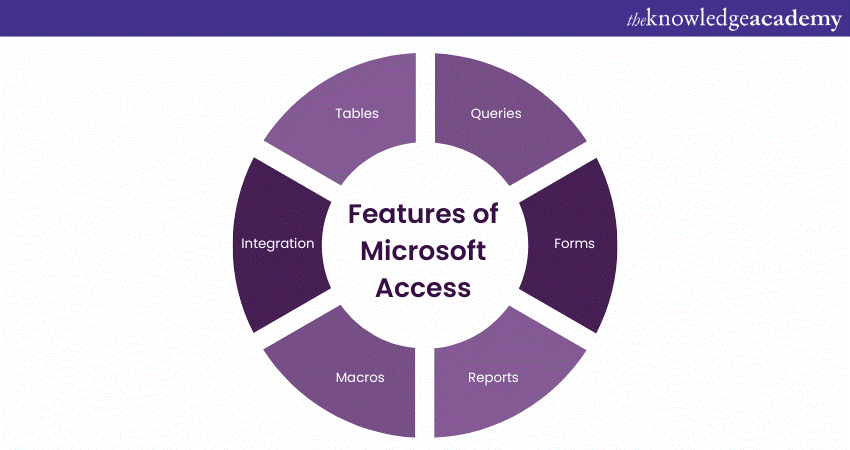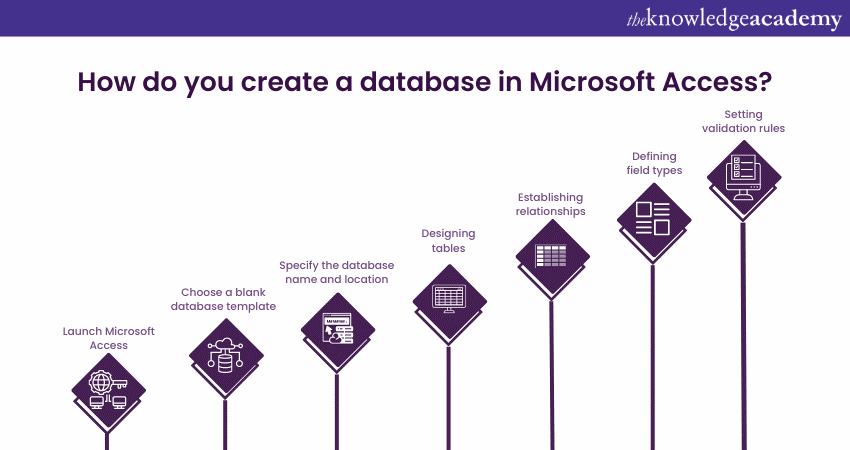We may not have the course you’re looking for. If you enquire or give us a call on 01344203999 and speak to our training experts, we may still be able to help with your training requirements.
Training Outcomes Within Your Budget!
We ensure quality, budget-alignment, and timely delivery by our expert instructors.

Data is arguably our most important resource in the modern digital world. The importance of harnessing data in streamlining operations and getting better insights has prompted organisations to store their data more conveniently and efficiently. One of the most popular systems that help organisations do so is Microsoft Access, which provides plenty of features to help businesses store and organise their data. This blog will tell you all you need to know about What is Microsoft Access, its features, and how to find your way around the Database Management System.
Table of Contents
1) What is Microsoft Access?
2) How do you create a database in Microsoft Access?
3) Data entry and manipulation in Microsoft Access
4) Security and Data Management in Microsoft Access
5) Conclusion
What is Microsoft Access?
Microsoft Access is a widely asked Database Management System that allows users to store, organise, and retrieve data efficiently. It offers a friendly user interface and a range of features that help make it an ideal tool for individuals as well as small to medium-sized businesses. Access has a number of key features, some of which are explained as follows:

Tables
Tables form the foundation of a Microsoft Access database. They allow users to store data in an organised and structured manner. With Access, you can create multiple tables to accommodate different types of data and establish relationships between them. Tables provide a logical structure for storing information, making it easier to retrieve and manipulate data efficiently.
Queries
Queries in Access enable users to perform complex searches and data analysis. By using queries, you can extract specific information from your database based on criteria and conditions. Access provides a user-friendly query builder that allows you to design queries visually, or you can write SQL queries directly for more advanced operations. Queries help you retrieve, filter, sort, and aggregate data based on your specific requirements.
Forms
Access offers customisable forms that enhance the data entry and viewing experience. Forms provide a user-friendly interface for interacting with the database. You can design forms with various controls such as text boxes, drop-down menus, checkboxes, and buttons, making it easier for users to input and access data. Forms improve data accuracy and streamline the process of entering and modifying data in your database.
Reports
Reports in Access allow you to generate professional-looking documents based on your database data. You can create custom reports to present data in a structured and visually appealing format. Access provides a range of formatting options, such as headers, footers, page numbers, and graphics, to help you design reports that meet your specific needs. Reports are ideal for presenting summaries, analyses, and printable versions of your data.
Macros
Macros in Access enable you to automate repetitive tasks and streamline your workflow. With the macro builder, you can create sequences of actions that Access will execute automatically. Macros can perform a wide range of tasks, such as opening forms, running queries, applying filters, and performing calculations. Automating tasks with macros helps to improve efficiency and reduce manual effort in managing your database.
Integration
Access seamlessly integrates with other applications in the Microsoft Office suite, such as Excel, Word, and Outlook. You can import and export data between Access and these applications, enabling seamless data exchange and analysis. For example, you can import data from an Excel spreadsheet into Access for further manipulation and analysis, or export Access reports to Word for generating documents.
How do you create a database in Microsoft Access?
Now that we know what is Microsoft Access used for, let us explore how to use the platform. Access provides a user-friendly interface for creating and managing databases. You must follow these steps to create a database in Access:

Step 1: Launch Microsoft Access
Launch Microsoft Access by clicking on its icon or by searching for it in the Start menu.
Step 2: Choose a blank database template
Upon launching Microsoft Access, you will be prompted to choose a template or create a blank database. Select the option for a blank database to start from scratch.
Step 3: Specify the database name and location
Next, specify the name and location for your database file. Choose a meaningful name that reflects the purpose of your database. Select an appropriate location on your computer or network where you want to save the database file.
Step 4: Designing tables
Tables are the foundation of a database in Microsoft Access. They store and organise data in a structured manner. To design tables:
1) Click on the "Table Design" option in the main Access window.
2) In the table design view, define the fields (columns) that you want to include in your table. Enter a field name, select the appropriate data type (such as text, number, date/time), and set any desired field properties.
3) Define the primary key for the table by selecting a field that uniquely identifies each record. You can set the primary key by right-clicking on the desired field and selecting "Primary Key".
4) Repeat the process to add additional fields to the table.
Step 5: Establishing relationships
If your database involves multiple tables with relationships, you need to establish those relationships. Relationships define how data in one table relates to data in another table. To establish relationships:
1) Click on the "Database Tools" tab in the Access ribbon.
2) Select the "Relationships" button to open the relationships view.
3) Drag and drop the related fields (usually the primary key and foreign key) from one table to another to create a relationship.
4) Set the type of relationship (such as one-to-one, one-to-many, or many-to-many) and enforce referential integrity if necessary.
Step 6: Defining field types
For each field in your table, choose an appropriate data type to store the corresponding data. Access provides various data types, such as text, number, date/time, and more. To define field types:
1) In the table design view, select the field for which you want to define the data type.
2) In the "Data Type" column, choose the appropriate data type from the dropdown list.
3) Set any additional properties specific to the chosen data type, such as field size, format, and validation rules.
Step 7: Setting validation rules
To ensure data integrity and accuracy, you can set validation rules for specific fields in your table. Validation rules enforce specific conditions that the data must meet. To set validation rules:
1) In the table design view, select the field for which you want to set a validation rule.
2) In the "Validation Rule" property, enter the rule using the appropriate syntax.
3) Optionally, provide a custom error message to display if the validation rule is violated.
Enhance your Microsoft Access skills with our comprehensive Microsoft Access Masterclass Course!
Data entry and manipulation in Microsoft Access
Now that we have a Microsoft Access summary of how to create databases, we will explore the concepts of data entry and manipulation. Once you have designed your tables and set up your database in Microsoft Office Access, you can start entering data and manipulating it as per your requirements. Here are the steps involved in data entry and manipulation:
Entering data
To enter data in a table in Access Microsoft, you will need to:
1) Open the table or form where you want to enter data.
2) Navigate to the first empty record or use the "New Record" button to create a new entry.
3) Enter data into the respective fields by typing directly or selecting values from drop-down menus or other input controls.
4) Move to the next record by pressing the "Tab" key or using the arrow keys.
5) Continue entering data into each record until you have completed the data entry process.
Sorting and filtering records
Access allows you to sort and filter records based on specific criteria to retrieve and view the data in a desired order. For sorting records, you will need to:
1) Open the table or form containing the records you want to sort.
2) Click on the column header of the field you want to sort by.
3) Click the "Sort Ascending" or "Sort Descending" button in the Access ribbon to arrange the records in ascending or descending order based on the selected field.
For filtering records, you will be required to:
1) Open the table or form where you want to apply a filter.
2) Click on the "Filter" button in the Access ribbon to open the filter options.
3) Specify the filter criteria by selecting values, entering text, or defining conditions for the desired fields.
4) Apply the filter to display only the records that meet the specified criteria.
Querying the database
Queries in Microsoft Access allow you to retrieve specific information from your database based on predefined criteria. You can create queries using the query builder or write SQL queries directly. Here's how you can query the database:
1) Open the "Queries" tab in the Access ribbon.
2) Click on the "New" button to create a new query.
3) Use the query builder to select the tables and fields you want to include in the query.
4) Specify the criteria and conditions for the query to filter the data based on your requirements.
5) Run the query to retrieve the results that match the specified criteria.
6) Save the query for future use or modify it as needed.
Generating reports
Access allows you to create professional-looking reports based on your database data. Here's how you can generate reports:
1) Open the "Reports" tab in the Access ribbon.
2) Click on the "New" button to create a new report.
3) Choose the report wizard or design view to create the report layout.
4) Select the tables, fields, and grouping options you want to include in the report.
5) Customise the report layout by adding headers, footers, page numbers, logos, and other elements.
6) Preview the report to see how it will appear when printed or exported.
7) Save the report for future use or modify it as needed.
Take your Microsoft Office skills to the next level – sign up for our Power Apps and Power Automate Training!
Security and Data Management in Microsoft Access
Ensuring the security and integrity of your data is crucial when managing a database. Microsoft Access offers several features and best practices to help you maintain data security and implement effective Data Management strategies. Here's how you can manage security and data in Access:
Setting user permissions
To control access to your database and protect sensitive information, you can set user permissions in Access. Here's how you can manage user permissions:
1) Open the database in Access.
2) Click on "File", and then select "Options".
3) In the "Access Options" dialogue box, click on "Current Database".
4) Set the desired permissions for different user roles.
5) Specify who can view, modify, delete, or create records and objects within the database.
6) Assign appropriate permissions to ensure that users have the necessary access without compromising data security.
Database backup and recovery
Regularly backing up your database is essential to prevent data loss and ensure its recoverability in the event of hardware failure, software issues, or accidental deletion. Here's how you can back up and recover your database:
1) Create a backup schedule to automatically back up your database at regular intervals.
2) Next, store the backups in a secure location, like a hard drive or cloud storage, to protect against data loss.
3) If a database issue occurs, you can restore a backup copy to recover the data.
4) Test the backup and recovery process periodically to ensure its effectiveness.
Compact and repair database
Over time, Access databases may become fragmented and less efficient due to deleted records, updated data, and database operations. Compacting and repairing the database helps optimise its performance and resolve potential issues. Here's how you can compact and repair your database:
1) Close the database in Access.
2) Make a backup copy of the database for safety.
3) Reopen Access and click on the "Database Tools" tab.
4) In the "Database Tools" group, click on "Compact and Repair Database".
5) Select the database file you want to compact and repair.
6) Click "Compact" to start the process.
Access will create a compacted and repaired version of the database file, improving its performance and resolving any potential issues.
Conclusion
All in all, Microsoft Access offers a versatile and user-friendly platform for managing data efficiently. Regardless of if you want to organise personal information or create a business database, Access provides the necessary tools to structure and manipulate data effectively. By following best practices and utilising its various features, users can streamline their Data Management processes and achieve optimal results. Hope this blog answered all your questions about What is Microsoft Access and much more!
Elevate your productivity with our Microsoft Office 365 Masterclass – unlock a world of digital possibilities!
Frequently Asked Questions
Upcoming Office Applications Resources Batches & Dates
Date
 Microsoft Access Training
Microsoft Access Training
Fri 14th Jun 2024
Fri 16th Aug 2024
Fri 18th Oct 2024
Fri 20th Dec 2024







 Top Rated Course
Top Rated Course



 If you wish to make any changes to your course, please
If you wish to make any changes to your course, please


